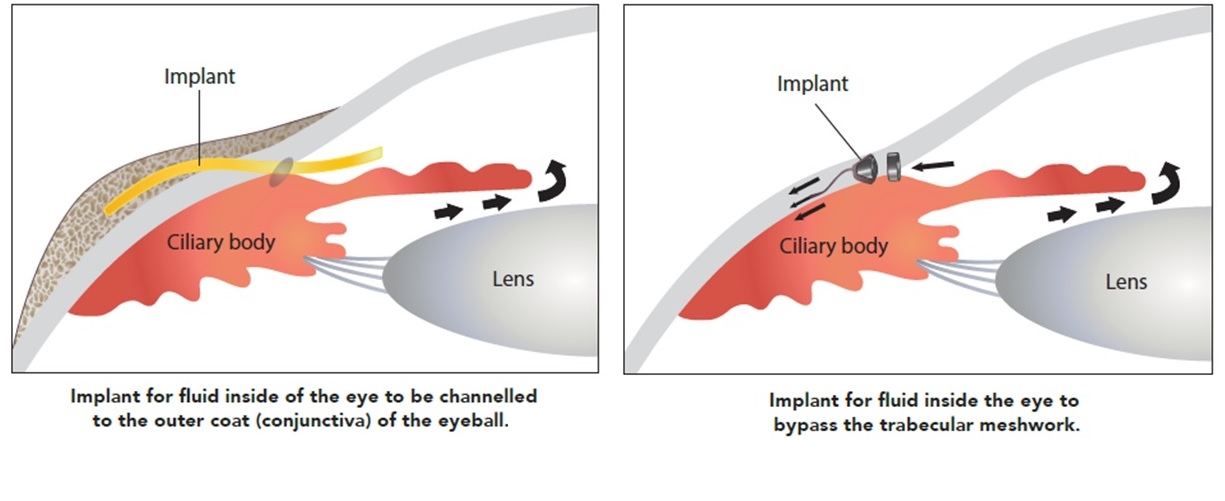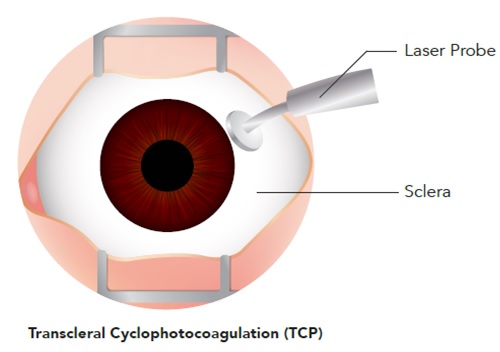There are five forms of surgery we may offer to you:
1) Trabeculectomy with mitomycin-C
This involves creating a channel for fluid to flow from the inside of the eye to a space beneath the outer coat (conjunctiva) of the eyeball. The channel is called a Trabeculectomy. Mitomycin-C is an anti-scarring medication that is used during surgery to improve success.
It works by preventing scarring which may close up the channel and reduce flow of fluid from the inside to outside of the eye.
2) Combined Cataract Surgery and Trabeculectomy with mitomycin-C
This is the same procedure as the one above (Trabeculectomy) but with the addition of cataract surgery. This is therefore a ‘two-in-one” operation where both your glaucoma and cataract are treated in one operation.
Quite frequently, you may have glaucoma plus a cataract that is affecting your vision. If this is the case, we may suggest performing this “two-in-one” operation to save you from having to undergo two separate operations, one for the glaucoma and the other for the cataract.
3) Glaucoma drainage (tube) implant
Here, instead of creating a channel, a specially designed tube implant is inserted into the eye, which allows flow of fluid through it.
The tube is inserted into the front chamber of the eye and is attached to a special plate, which looks like a very small computer mouse.The special plate is placed in the space beneath the outer covering (conjunctiva) of the eyeball. Fluid leaves the tube implant and is absorbed by the surrounding blood vessels. This plate is therefore covered by the outer covering (conjunctiva) of the eyeball.
This implant is designed to be left in your eye for life and does not need to removed unless there are special reasons to do so. The surgery may also be carried out as a “two-in-one” operation together with cataract surgery if your cataract has affected your vision. The anti-scarring medication, mitomycin-C may also be applied.
We may offer this surgery to you when your glaucoma is more complex or where previous surgery has not been successful.
4) Minimally Invasive Glaucoma Surgery (MIGS)
This group of surgeries use microscopic instruments and specially designed implants to lower eye pressure. The standard glaucoma surgeries (e.g. trabeculectomy) are often effective in lowering eye pressure but they may also have complications. MIGS was developed to try to reduce complications. MIGS however may trade off some effectiveness (they may not lower eye pressure as much as a trabeculectomy), for safety.
Many of these specially designed implants are inserted in the front chamber of the eye and act as channels for fluid inside the eye to bypass the trabecular meshwork (filter of the drainage system inside the eye) or for fluid inside of the eye to be channelled to the outer coat (conjunctiva) of the eyeball or the suprachoroidal space (space between the wall of the eye and the retina).
These implants are designed to be left in your eye for life and do not need to be removed unless there are special reasons to do so.
Quite frequently, some patients may have mild or stable glaucoma plus a cataract that is affecting vision. If this is the case, we may suggest performing a “two-in-one” MIGS combined with cataract surgery. This is to save you from having to undergo two separate operations, and to possibly reduce your need for eye drops.

5) Cyclophotocoagulation
This is a laser procedure and involves applying laser to the part of the eye which produces fluid in the eye called the ciliary processes. By applying laser to the ciliary processes, fluid produced in the eye is reduced which in turn lowers the eyeball pressure.
This form of treatment is usually reserved for more advanced glaucoma or in patients who are too ill or too old to undergo other operations which take longer to perform.

Who will benefit from this surgery?
Patients who:
- need to lower their eye pressure further even after trying several different treatments with various eye drops and maybe even laser or previous surgery
- have difficulty using eye drops because of:
- allergy or other side-effects
- confusion or forgetfulness in applying the eye drops
- conditions such as stroke or arthritis which make applying eye drops hard to do - are on eye drops for glaucoma and prefer to reduce the number of eye drops needed
